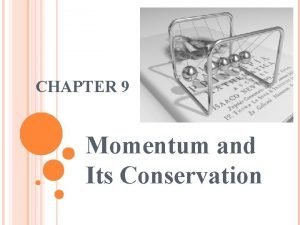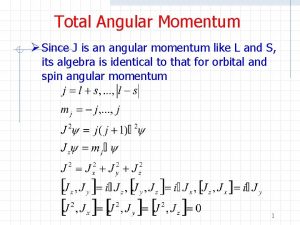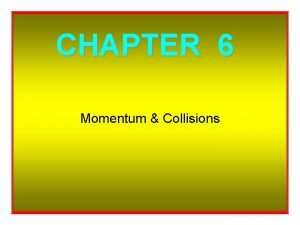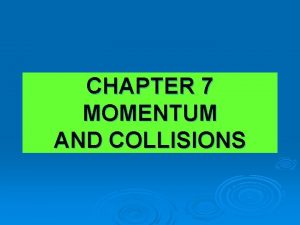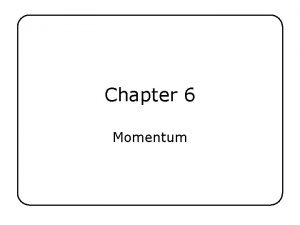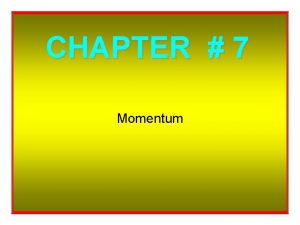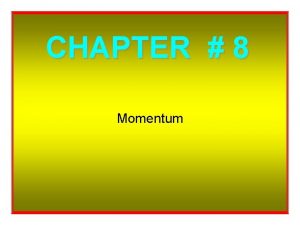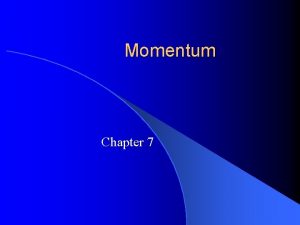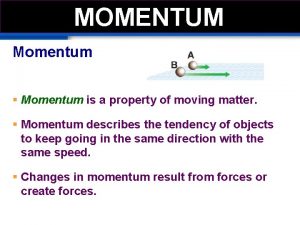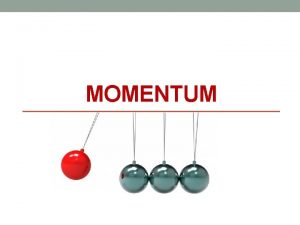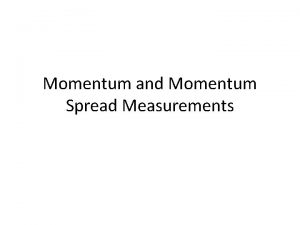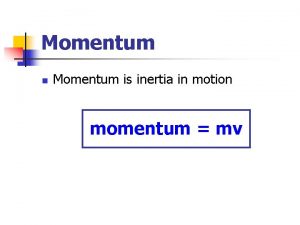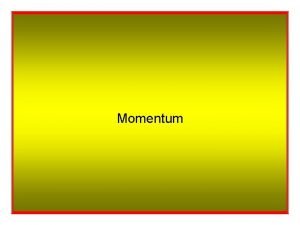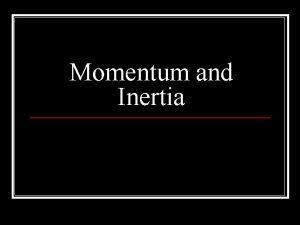Chapter 8 Momentum Definition of Total Momentum The































- Slides: 31


Chapter 8 Momentum


Definition of Total Momentum The total momentum P of any number particles is equal to the vector sum of the momenta of the individual particles: P = PA + PB + PC + ……. ( total momentum of a system of particles)

• Analysis of a collision

Conservation of Momentum The total momentum of a system is constant whenever the vector sum of the external forces on the system is zero. In particular, the total momentum of an isolated system is constant.

An astronaut rescue

Rifle recoil


In collisions, we assume that external forces either sum to zero, or are small enough to be ignored. Hence, momentum is conserved in all collisions.

Elastic Collisions In an elastic collision, momentum AND kinetic energy are conserved. p f = pi and kf = ki


Inelastic Collisions In an inelastic collision, the momentum of a system is conserved, pf = pi but its kinetic energy is not, Kf ≠ Ki Completely Inelastic Collisions When objects stick together after colliding, the collision is completely inelastic. In completely inelastic collisions, the maximum amount of kinetic energy is lost.


USING BOTH CONSERVATION OF MOMENTUM AND CONSERVATION OF TOTAL ENERGY

The ballistic pendulum •

A 2 Dimensional collision problem

Work, Kinetic Energy and Potential Energy Kinetic energy is related to motion: K = (1/2) mv 2 Potential energy is stored: Gravitational: U = mgh Spring: U = (1/2)kx 2

Conservation/Conversion • Work-Energy Theorem Wtotal = Kf – Ki • Conservatives force Kf + Uf = Ki + Ui • Non-conservative forces Kf + Uf = Ki + Ui + Wother • Onservation of momentum pf = pi

Off center collisions


A ball of mass 0. 240 kg moving with speed 12. 2 m/s collides head-on with an identical stationary ball. (Notice that we do not know the type of collision. ) Which of the following quantities can be calculated from this information alone? A) The force each ball exerts on the other B) The velocity of each ball after the collision C) Total kinetic energy of both balls after the collision D) Total momentum of both balls after the collision

The center of mass of a system of masses is the point where the system can be balanced in a uniform gravitational field.

Center of Mass for Two Objects Xcm = (m 1 x 1 + m 2 x 2)/(m 1 + m 2) = (m 1 x 1 + m 2 x 2)/M


Locating the Center of Mass In an object of continuous, uniform mass distribution, the center of mass is located at the geometric center of the object. In some cases, this means that the center of mass is not located within the object.


Suppose we have several particles A, B, etc. , with masses m. A, m. B, …. Let the coordinates of A be (x. A, y. A), let those of B be (x. B, y. B), and so on. We define the center of mass of the system as the point having coordinates (xcm, ycm) given by xcm = (m. Ax. A + m. Bx. B + ………. )/(m. A + m. B + ………), Ycm = (m. Ay. A + m. By. B +………. )/(m. A + m. B + ………).

The velocity vcm of the center of mass of a collection of particles is the mass-weighed average of the velocities of the individual particles: vcm = (m. Av. A + m. Bv. B + ………. )/(m. A + m. B + ………). In terms of components, vcm, x = (m. Av. A, x + m. Bv. B, x + ………. )/(m. A + m. B + ………), vcm, y = (m. Av. A, y + m. Bv. B, y + ………. )/(m. A + m. B + ………).

For a system of particles, the momentum P is the total mass M = m. A + m. B +…… times the velocity vcm of the center of mass: Mvcm = m. Av. A + m. Bv. B + ……… = P It follows that, for an isolated system, in which the total momentum is constant the velocity of the center of mass is also constant.

Acceleration of the Center of Mass: Let acm be the acceleration of the cener of mass (the rate of change of vcm with respect to time); then Macm = m. Aa. A + m. Ba. B + ……… The right side of this equation is equal to the vector sum ΣF of all the forces acting on all the particles. We may classify each force as internal or external. The sum of forces on all the particles is then ΣF = ΣFext + ΣFint = Macm
 Chapter 6 momentum changing momentum
Chapter 6 momentum changing momentum Activo promedio
Activo promedio Total revenues minus total costs equals
Total revenues minus total costs equals Total revenues minus total costs equals
Total revenues minus total costs equals Total revenues minus total costs equals
Total revenues minus total costs equals Total revenue minus total expenses
Total revenue minus total expenses Conservation momentum
Conservation momentum Glancing collision
Glancing collision The total angular momentum j=______.
The total angular momentum j=______. Hát kết hợp bộ gõ cơ thể
Hát kết hợp bộ gõ cơ thể Ng-html
Ng-html Bổ thể
Bổ thể Tỉ lệ cơ thể trẻ em
Tỉ lệ cơ thể trẻ em Voi kéo gỗ như thế nào
Voi kéo gỗ như thế nào Glasgow thang điểm
Glasgow thang điểm Alleluia hat len nguoi oi
Alleluia hat len nguoi oi Môn thể thao bắt đầu bằng chữ đua
Môn thể thao bắt đầu bằng chữ đua Thế nào là hệ số cao nhất
Thế nào là hệ số cao nhất Các châu lục và đại dương trên thế giới
Các châu lục và đại dương trên thế giới Cong thức tính động năng
Cong thức tính động năng Trời xanh đây là của chúng ta thể thơ
Trời xanh đây là của chúng ta thể thơ Mật thư tọa độ 5x5
Mật thư tọa độ 5x5 Phép trừ bù
Phép trừ bù Phản ứng thế ankan
Phản ứng thế ankan Các châu lục và đại dương trên thế giới
Các châu lục và đại dương trên thế giới Thể thơ truyền thống
Thể thơ truyền thống Quá trình desamine hóa có thể tạo ra
Quá trình desamine hóa có thể tạo ra Một số thể thơ truyền thống
Một số thể thơ truyền thống Cái miệng xinh xinh thế chỉ nói điều hay thôi
Cái miệng xinh xinh thế chỉ nói điều hay thôi Vẽ hình chiếu vuông góc của vật thể sau
Vẽ hình chiếu vuông góc của vật thể sau Nguyên nhân của sự mỏi cơ sinh 8
Nguyên nhân của sự mỏi cơ sinh 8 đặc điểm cơ thể của người tối cổ
đặc điểm cơ thể của người tối cổ







